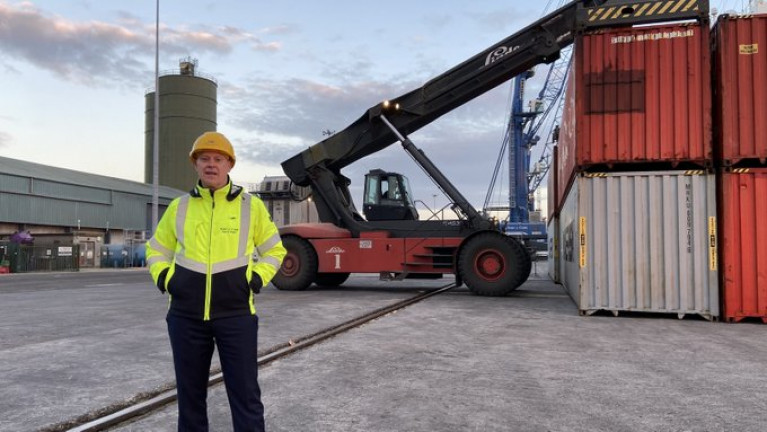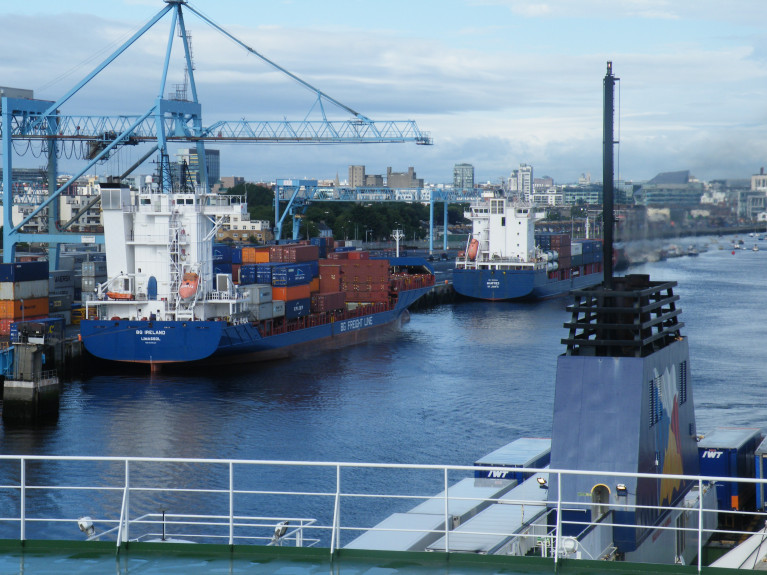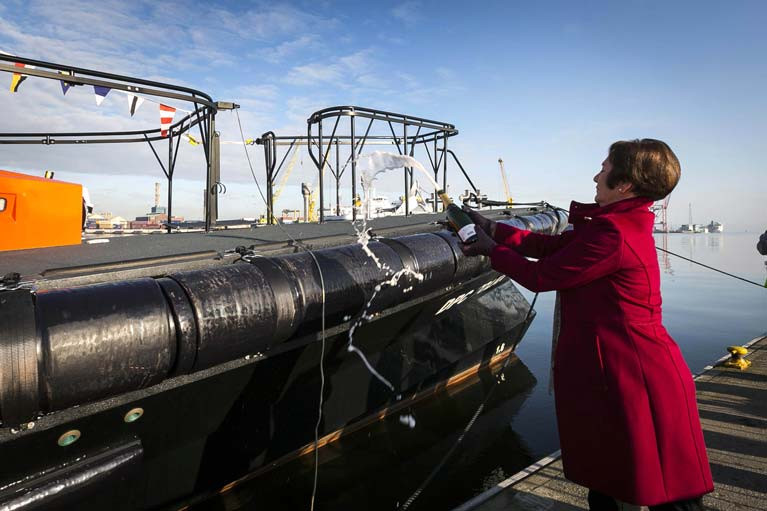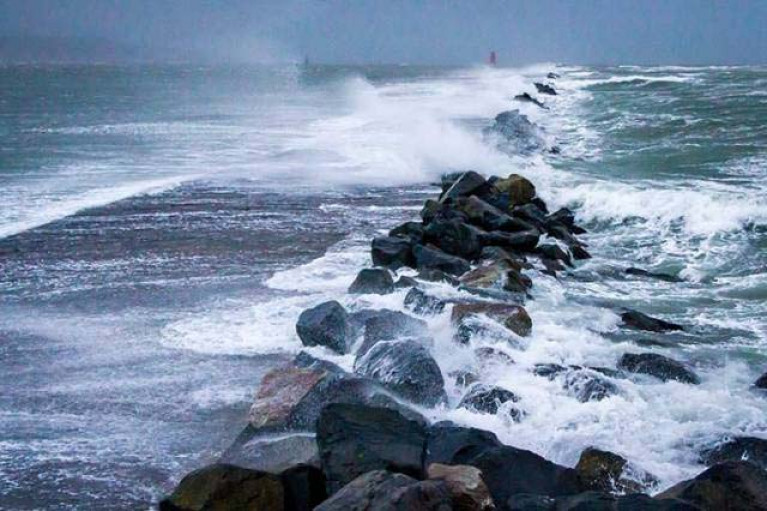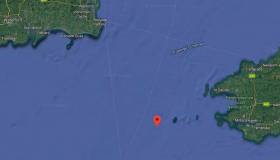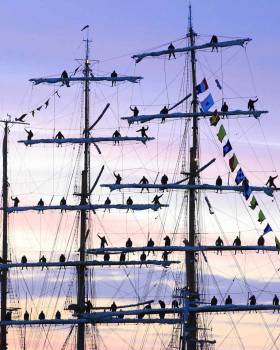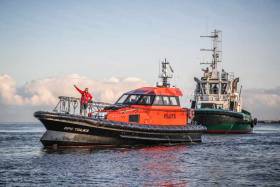Displaying items by tag: Dublin Port
Operators of Dublin and Cork ports have said imports of food and other essential items have increased since the Covid-19 outbreak here over a month ago.
According to RTE News, the ports said contingencies are in place to ensure ports stay open and supply chains remain intact.
Their trading figures indicate the Covid-19 outbreak has seen increased demand for food and other essential items.
This is backed up by evidence of panic buying and empty supermarket shelves.
The Port of Cork insists that trade is up and supply chains have been unaffected by the coronavirus outbreak.
At Cork's deep water terminal in Ringaskiddy, unloading of a Portuguese cargo ship, AS Petronia, began at 5am.
The ship left Costa Rica in Central America a fortnight ago, and tied up in Ringaskiddy in the early hours of this morning.
Ireland is its first port of call. The ship is carrying more than 2,000 shipping containers which are destined for ports all over Europe.
There were around 100 shipping containers for Ireland on board, carrying mangos, melons and pineapples, along with four million bananas - a mere week's supply to keep this country going.
More on this story by clicking here.
In recent months the concept of a fixed link between Ireland and Britain has been rapidly developing as various politicians have proposed bridges between Northern Ireland and Scotland across the narrow, storm-tossed and tide-riven waters of the North Channel.
But while the distance between Fair Head on the northeast corner of Antrim and the Mull of Kintyre in West Scotland is barely 13 miles, as one critic has pointed out, this would be a link “from the back of beyond to the middle of nowhere”. For even when Scotland has been reached at Kintyre, any traffic would have hundreds of miles of driving before getting anywhere near the main road system, let alone the primary motorway routes.
As for a connection across the established ferry route between Larne in Northern Ireland and Stranraer in southwest Scotland, that would also bring traffic from Ireland into a relatively remote part of Scotland, with a long slow drive to the nearest part of the motorway system towards Carlisle in northwest England. That in turn then involves a long haul through the notoriously congested M6 in order to connect with other main routes into the prosperous southeast of England and on into mainland Europe.
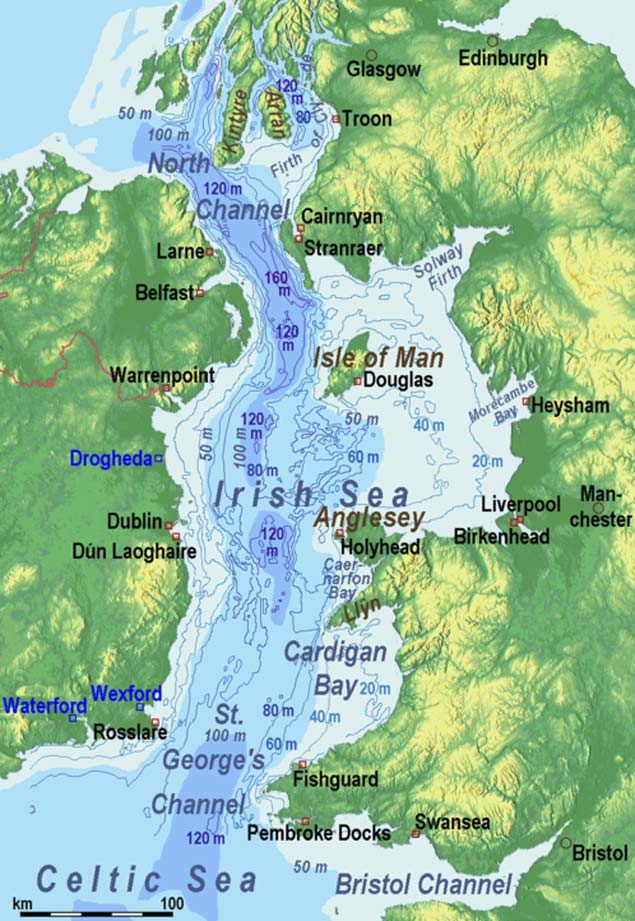 The challenges of providing a fixed link between Ireland and Britain are abundantly clear in this image, with the 160 metres depth of the explosives-filled Beaufort Dyke in the southern North Channel clearly in evidence. In terms of providing a relatively level seabed for the proposed Brunel Link from the greater Dublin area to North Wales, it looks as though a straight line between Skerries and Holyhead would offer the best option
The challenges of providing a fixed link between Ireland and Britain are abundantly clear in this image, with the 160 metres depth of the explosives-filled Beaufort Dyke in the southern North Channel clearly in evidence. In terms of providing a relatively level seabed for the proposed Brunel Link from the greater Dublin area to North Wales, it looks as though a straight line between Skerries and Holyhead would offer the best option
But in any case, it has been pointed out that a Larne-Stranraer link would be considerably longer than the shorter County Antrim link between Black Head in Northern Ireland and Corsewall Point in Scotland. Yet both of these would involve difficult shoreside access, whereas a link slightly further south from Donaghadee in County Down through the nearby Copeland Island and across to Portpatrick in Scotland is only about 20 miles, although putting a motorway through the choice residential districts of North Down and across Copeland Island might meet with some local resistance.
In any case, in this area, the North Channel includes the 160 metres deep fissure which is the Beaufort Dyke, a hidden depth which has the added hazard of use as a dumping group for explosives – millions of them – after World War II ended in 1945. Even after 75 years, there is no reason to assume that they still are anything other than extremely dangerous.
Yet in theory, a viable bridge could be built at this point, for civil engineers reckon anything is possible if they’re only given enough resources to do it. Nevertheless, even though it might be less expensive than a tunnel, it boggles the mind to think of the expenditure which would be required to create a bridge structure which could withstand the really extreme conditions of the North Channel, and thus another idea which has been around for some time has been put forward as a possible solution.
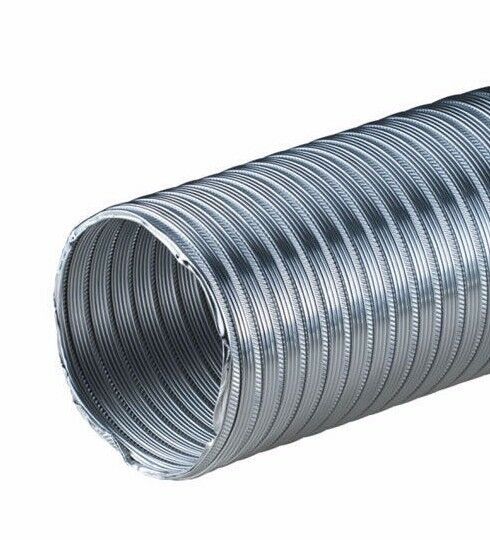 The basic structure of the Brunel Link is very simple. In the completed full-size project, a motorway standard dual carriageway with three lanes either side will be in place across the middle, while a two-line railway will run along the floor.
The basic structure of the Brunel Link is very simple. In the completed full-size project, a motorway standard dual carriageway with three lanes either side will be in place across the middle, while a two-line railway will run along the floor.
This is the Bridge/Tunnel, the “Brunnel”, which is somewhere between a bridge and a tunnel. It is in effect a giant tube which is laid along the sea-bed in such a way that it flexibly follows the contours when they are reasonably even, but by its nature, the structure can be reinforced to become a rigid tube-bridge when it is necessary to cross an undersea valley.
As the portmanteau name of Brunnel is so near to the surname of Brunel to remind us of the great Victorian engineer-builder Isambard Kingdom Brunel (who would be just the man for a massive and visionary project of this nature), the concept is becoming known as the Brunel Link. And its potential for being extruded in virtually infinite lengths by a giant (and we really mean giant) tube-making machine from a reinforced mixture of concrete and advance epoxies has been taken into consideration by a mysterious Dublin-based organisation known as the Committee for the Re-Alignment of Ports.
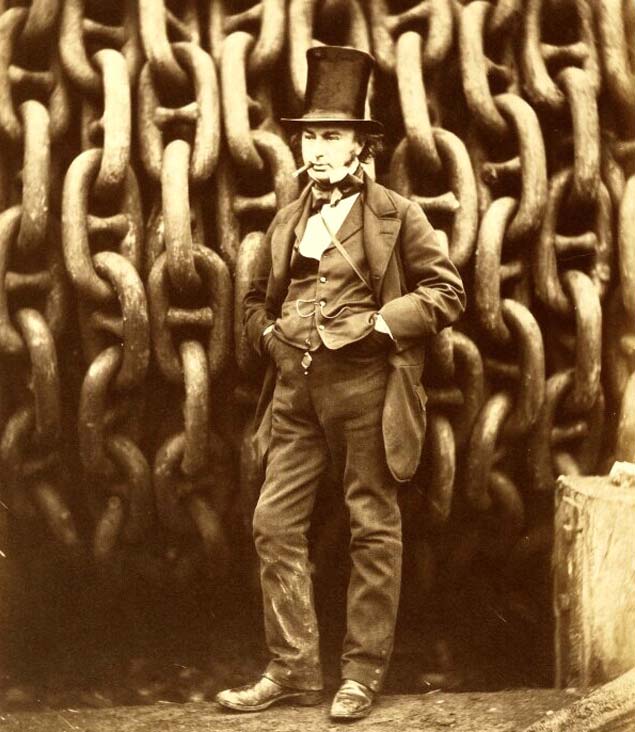 The greatest engineer? Isambard Kingdom Brunel (1806-1859) has been deservedly honoured in the name of the Brunel Link.
The greatest engineer? Isambard Kingdom Brunel (1806-1859) has been deservedly honoured in the name of the Brunel Link.
Basically, this Committee is primarily concerned with connecting Ireland as directly as possible with the most prosperous and industrious part of middle and southeast England, which in turn gives connections into the commercial, financial and industrial heartlands of Europe. In order to achieve this, they have concluded that the key arterial route to be followed would be based around the Dublin to Holyhead route.
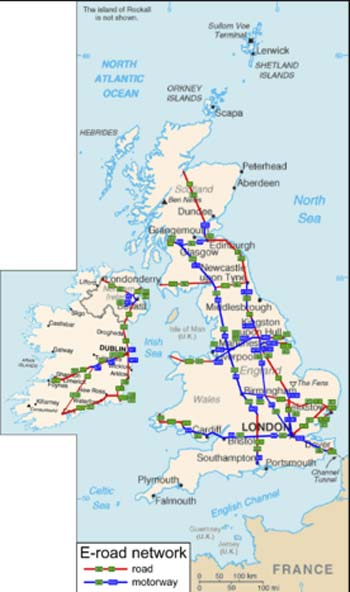 The logic of the Dublin-Holyhead link as the most efficient inter-connector from the island of Ireland to Britain’s industrial and commercial heartlands and on into mainland Europe is evident from this map of the main routes
The logic of the Dublin-Holyhead link as the most efficient inter-connector from the island of Ireland to Britain’s industrial and commercial heartlands and on into mainland Europe is evident from this map of the main routes
Thus the Committee’s plan is for a Brunel cross-channel tube connection from somewhere on the coast of the Greater Dublin region to Holyhead, the structure to be of sufficient diameter to accommodate a dual carriageway motorway with three lanes either side, plus vitally important hard shoulders, at its widest horizontal diameter, and below this would be a twin-track railway system running along the Brunel Link floor which will somehow accommodate the differing railway gauges to be found on either side of the Irish Sea.
As the impetus for this huge project is essentially coming from the Irish side, the group behind it plan to invest heavily in Holyhead harbourside property. In fact, one development of this idea is that Ireland should buy Holy Island, the offlyer beside Anglesey on which Holyhead is located, and make it in effect an extension of the Irish Republic. Ideally, in fact, the promoters would like to take over the entire island of Anglesey to provide Dublin with the potential for an easterly extension and its useful hinterland.
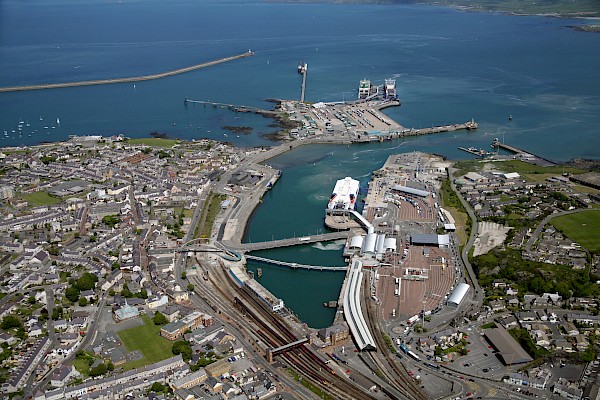 With the Brunel Link in place, the port of Holyhead could have a brighter future as an extension of Dublin Port.
With the Brunel Link in place, the port of Holyhead could have a brighter future as an extension of Dublin Port.
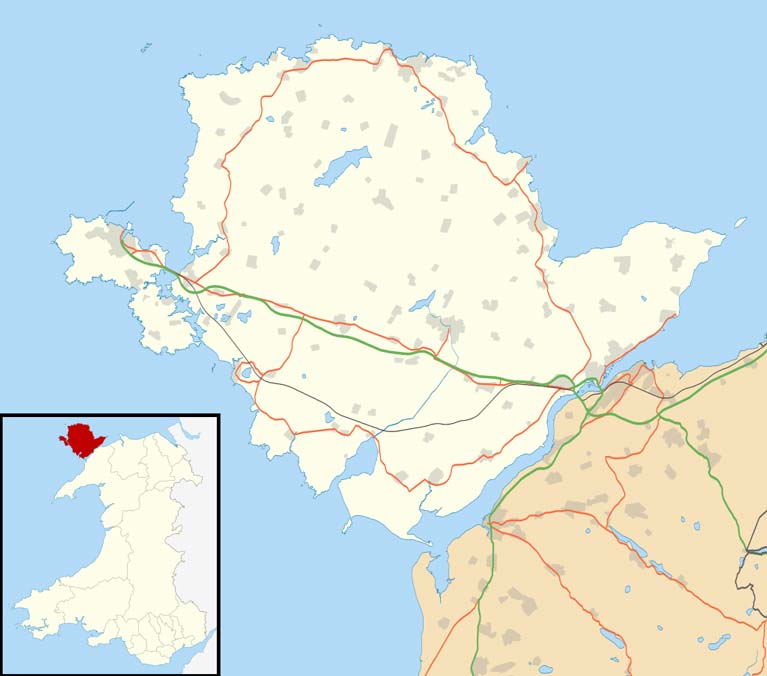 The promoters of the Brunel Link are thinking in terms of initially taking over Holy Island on which Holyhead is located, and ideally, they hope to buy all of Anglesey in due course to provide Dublin with a viable eastern hinterland.
The promoters of the Brunel Link are thinking in terms of initially taking over Holy Island on which Holyhead is located, and ideally, they hope to buy all of Anglesey in due course to provide Dublin with a viable eastern hinterland.
At the moment that is only the stuff of dreams, but with the Brunel cross-channel connection, the entire geography of the northern area of St George’s Channel would be changed. With Anglesey less than an hour’s drive away from Dublin regardless of the weather, Holyhead could be transformed from an economic blackspot into becoming part of one of Europe’s most successful technical and financial hubs.
This ready access to Holyhead would, in turn, add another option to the regularly-issued demand by high-flown economic commentators and urban planners that Dublin Port be moved entirely out of the city in order to facilitate the “proper 21st Century potential” of the Capital. Those of us who think that the regular and much-observed ship movements in and out of the Port and Dublin Bay are integral to the character of the city may disagree with this, but nevertheless it’s interesting to see how the Holyhead option may affect the overall thinking.
For the “Move the Port out of the City” movement assumes that somewhere else can be conveniently found to place the large and complex infrastructure of Dublin port. Yet no remotely comparable natural harbour exists any nearer than Carlingford Lough to the north, and Wexford Harbour to the south, while the proposals for a new port at Bremor close north of Balbriggan seem to take no account of the need there would be for the construction of massive new breakwaters to create an artificial harbour which would have to be many times the size of Dun Laoghaire.
Yet with Holyhead brought into the equation through the Brunel Link, valuable land on the East Coast of Ireland could be retained for residential and recreational use, while an under-utilised industrial area and harbour on the Welsh coast could be brought to life as an extension of Dublin port.
 Sunset for Dublin Port? With ferry operations removed by the opening of the Brunel Link to Holyhead, and with Holyhead thereby enabled to take over the freight services of Dublin, the way would be clear for the Dublin port area to be re-developed for residential, office and recreational use.
Sunset for Dublin Port? With ferry operations removed by the opening of the Brunel Link to Holyhead, and with Holyhead thereby enabled to take over the freight services of Dublin, the way would be clear for the Dublin port area to be re-developed for residential, office and recreational use.
Behind all this re-alignment of ports, the new arterial connection from the heart of Ireland through Britain to the heart of Europe would be made even more viable in several obvious ways. With the rapidly increased use of electrically-powered vehicles in the near future, the convenience and environmental compatibility of the Brunel Link, and the inescapable logic of its location, arguably make the visionary proposals from the Committee for the Re-Alignment of Ports a real no-brainer.
Sea Trade for Dublin Port Set for 17% Hit Due to Covid-19
Dublin's sea trade which is around 17% could be affected by the coronavirus pandemic according to the Dublin Port Company.
It a statement the company says it "fully expects" a fall-off when the next quarterly results are published.
It says that 17% of trade in the port is with deep sea destinations such as China, which are "exposed" to the impact of the virus.
"We know that we will see a reduction in volumes affecting this portion of our trade, but we cannot comment meaningfully on the impact until after the end of the first quarter".
More on the story RTE reports here.
New Dublin Port Pilot Boat 'Tolka' Christened
Dublin Port Company has today officially christened its new Pilot Boat, DPC Tolka, in a short ceremony held at Poolbeg Yacht Club. The state-of-the-art vessel arrived in Dublin Port in December.
Father Ivan Tonge of Ringsend Parish and Reverend William Black, Port Chaplin from the Mission to Seafarers, blessed the 17.1-metre vessel before the boat’s godmother, Eileen Murray, carried out the traditional smashing of a champagne bottle on its bow. Eileen, a local of Ringsend, is the Vice Commodore of Poolbeg Yacht Club and her father was one of its founding members.
 Eamonn O’Reilly, Chief Executive of Dublin Port Company Dublin at the Tolka Christening ceremony
Eamonn O’Reilly, Chief Executive of Dublin Port Company Dublin at the Tolka Christening ceremony
As Afloat reported previously, DPC Tolka is the newest addition to the port’s fleet of working vessels, which includes tug boats Shackleton and Beaufort, multi-purpose workboat the Rosbeg, and pilot boats Liffey and Camac. She replaces the Port’s oldest pilot boat Dodder, which was retired from service after 23 years.
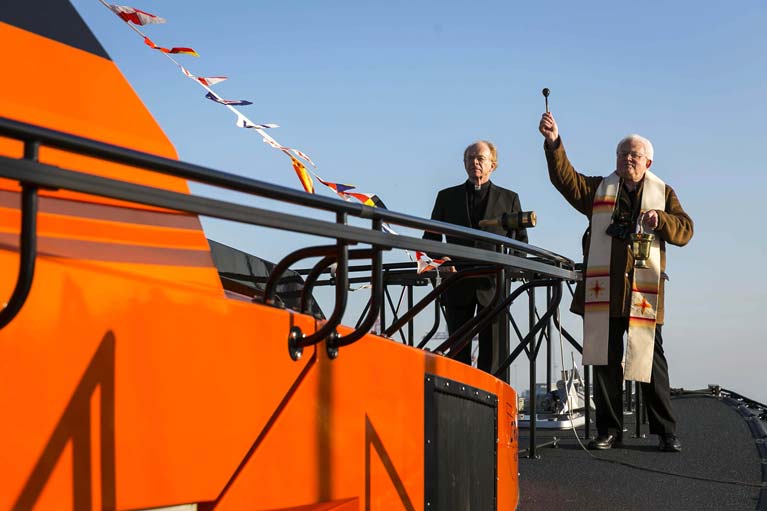 Father Ivan Tonge of Ringsend Parish and Reverend William Black, Port Chaplin from the Mission to Seafarers, blessed the 17.1-metre vessel
Father Ivan Tonge of Ringsend Parish and Reverend William Black, Port Chaplin from the Mission to Seafarers, blessed the 17.1-metre vessel
DPC Tolka represents a vital upgrade in the provision of pilotage services at the Port and will allow Dublin Port’s team of highly skilled marine pilots to reach and board large ships in all weather conditions from a greater distance out into Dublin Bay. Pilots have been training on the new vessel since her arrival.
Eamonn O’Reilly, Chief Executive, Dublin Port Company, said: “The christening of a new vessel is a longstanding tradition and I cannot think of a more suitable godmother to the Tolka than Vice Commodore Murray, whose family are steeped in Poolbeg Yacht Club’s history. I thank Eileen and the Club for hosting this event today and Dublin Port looks forward to continuing to work closely with both the local community and sailing organisations in the future.”
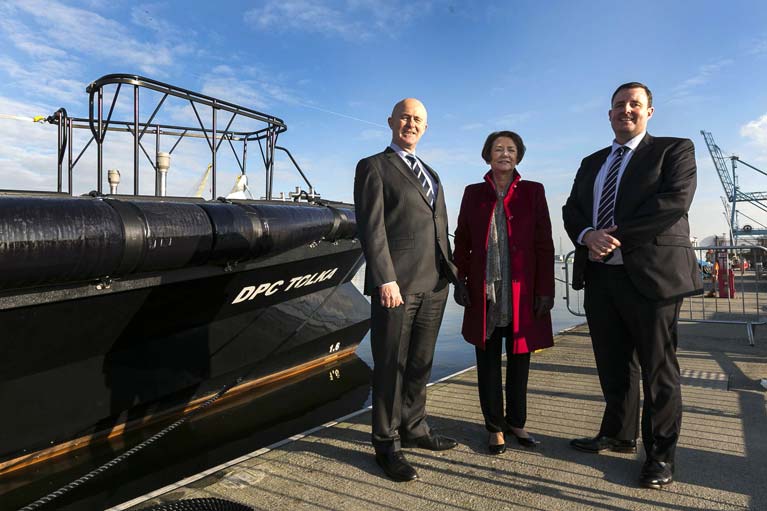 (From left) Dublin Port CEO Eamonn O’Reilly, Eileen Murray and Dublin Port Harbour master Captain Michael McKenna
(From left) Dublin Port CEO Eamonn O’Reilly, Eileen Murray and Dublin Port Harbour master Captain Michael McKenna
Hopes High for Dublin Dock Workers' Preservation Society Photo Archive
Good news from the Dublin Dock Workers' Preservation Society in their attempts to save their 6,000 historical photographs collection. The problem was reported earlier this week on Afloat.
Declan Byrne of the Society says: "We have been overwhelmed by the offers of help and support to preserve our archive. We are meeting up with Lar Joye Port Heritage Director of Dublin Port Company"
Hopefully, there will be a positive outcome and the important collection will be saved.
There has been 'terrible news' reported for Dublin Dock Workers' preservation society who need urgent help to preserve records stored on the internet.
The Dublin Dock Workers’ Preservation Society was set up nine years ago, in early 2011.
It is composed of ex-dock workers and people interested in preserving the history of Dublin Port. It has successfully held a number of exhibitions and raised awareness of the culture, history and tradition of Dublin Docks and Dock Workers.
It started by collecting historic photographs and has amassed a collection of 6,000 but is now in danger of losing them all and is seeking urgent help to preserve them.
Today came what one of its leaders, Declan Byrne, described as: “Terrible News.”
He said: “We have been notified that we are losing the internet site where we store our 6,000 donated photographs. We used this bluemelon site because people could download the photographs for free. We have now been told: "Your Bluemelon subscription is set to expire on 07-Feb-2020. Unfortunately, due to recent changes in the industry, we are no longer able to offer you an extension for your subscription. Your account will expire on 2020-02-08 and your files will be deleted. Thank you for the time you have spent with Bluemelon."
Declan told me: “We do not have the resources or personnel to download the photos and save them. Any help would be greatly appreciated.”
So, is there someone with the knowledge, resource, ability, to help preserve this valuable collection for the Society.
Email offers of help to Declan Byrne: [email protected]
As Storm Brendan is forecast to arrive on Monday morning, 13th January 2020, combined with a period of high tides, Dublin Port Company will temporarily close public access to the Great South Wall and the North Bull Wall Bridge on Monday from the following times:
- Great South Wall from 1100hrs - 1600hrs
- North Bull Wall Bridge from 1200hrs - 1430hrs
In Dublin on Monday there is an ORANGE wind warning in effect from 0800hrs -1500hrs.
The Marine forecast for the Irish Sea is a RED warning with strong gale force (Force 9) to storm force (Force 10). There will be heavy rain from 1200hrs - 1500hrs.
High tide at 1311hrs is predicted to reach 5.09m and Dublin City Council is activating flood defences.
The Great South Wall closure is due to tide height and dangerous winds on the exposed wall surface. The Bull Bridge closure is due to tide height.
Delays to some shipping activity is expected, including possible delays at the port’s LOLO container terminals, i.e. where containers are loaded and unloaded by crane.
With wind and rain expected until Thursday this week, Dublin Port Company will continue to monitor the situation.
Cargo Ship Loses Containers Enroute to Dublin
A cargo ship en route to Dublin Port was caught in this week's storms and lost at least 12 containers overboard.
The Maritime Bulletin reports that the ship 'Elbcarrier' lost the containers in the Celtic Sea on the afternoon of Sunday, December 8, while en route from Rotterdam to Dublin and being caught in rough seas.
The Bulletin's reporter is Erofey Schkvarkin, a Merchant Marine Captain, who also writes that 12 drifting containers were spotted at 2330 UTC in vicinity 51 40N 005 50W.
The ship reached Dublin in the afternoon Dec 9. More on this in the Maritime Bulletin here
Containers Blown Over
Separately, a reader has sent Afloat photo of containers blown over in Dublin Port in high winds this week.
 Shipping containers capsized in Dublin Port this week
Shipping containers capsized in Dublin Port this week
Dublin Port: Year in Review 2019
As the main gateway for trade in and out of Ireland, 2019 has been a year of exceptional progress and growth at Dublin Port on several fronts
No. 11 Liffey Ferry returns
The start of 2019 saw the return of an old favourite on the River Liffey with the re-launch of Dublin’s original No. 11 Liffey Ferry after a 35-year absence. The much-loved ferry service had been vital in linking the North and South docks communities but was decommissioned in 1984 following the completion of the East Link Bridge. Affectionately known as ‘the dockers’ taxi’, Dublin Port Company purchased the boat in 2016 from Ringsend man and former port worker Richie Saunders. Richie had salvaged and preserved the ferry, hoping one day to see her back on the River. A joint restoration project by Dublin Port Company and Dublin City Council saw the ferry restored to her former glory and given a new lease of life. Now operated by the Irish Nautical Trust, she can be seen ferrying a new generation of passengers between the 3Arena, Sir John Rogerson’s Quay and North Wall Quay.
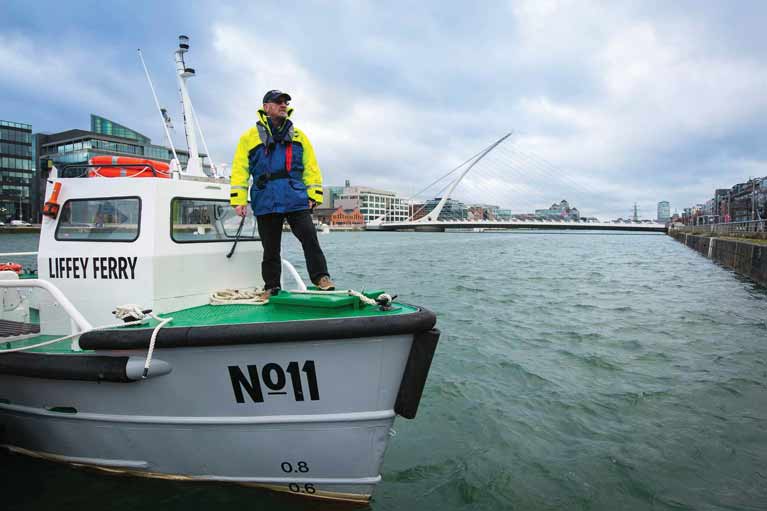 The much-loved No.11 Liffey Ferry service returned in 2019
The much-loved No.11 Liffey Ferry service returned in 2019
MV Laureline Sails Direct
With 8,000 ship arrivals per year, Dublin Port is a hive of activity all year round. In recent years, Ro-Ro services on direct routes between Dublin and Continental Europe (Rotterdam, Zeebrugge and Cherbourg) have commenced and large new ships such as CLdN’s MV Celine and Irish Ferries’ W.B. Yeats have been deployed. In March 2019, we welcomed the addition of CLdN’s MV Laureline, now the second biggest freight ferry to service Dublin Port and a sister ship of the Brexit Buster MV Celine. Her first departure from Dublin Port coincided with “Brexit Day”, the original date of March 29th when the UK was expected to exit the European Union.
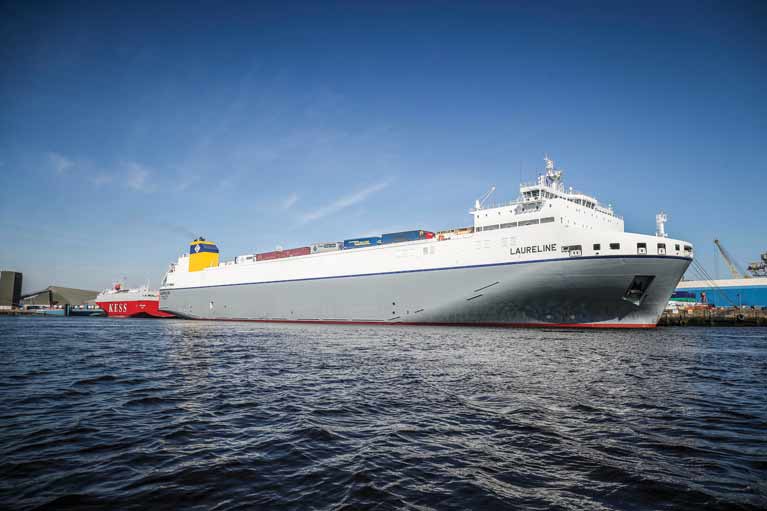 CLdN’s MV Laureline, now the second-biggest freight ferry to service Dublin Port and a sister ship of the Brexit Buster MV Celine
CLdN’s MV Laureline, now the second-biggest freight ferry to service Dublin Port and a sister ship of the Brexit Buster MV Celine
Brexit
Preparations for Brexit continued during the year, with Dublin Port providing the lands and infrastructure required by State Agencies for primary and secondary border inspection posts. Combined, the new set of inspection facilities spans almost 8 hectares of land within the port estate and follows a €30 million investment by Dublin Port Company in both the construction and the acquisition of assets to facilitate this.
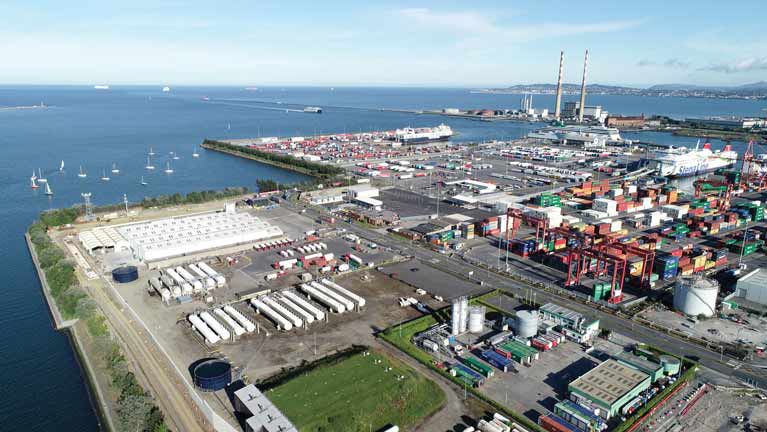 The MP2 Project will involve development works within existing port lands
The MP2 Project will involve development works within existing port lands
Future of Cruise Tourism
It is within the context of the ABR Project that the company has launched a public consultation on the future of cruise tourism at Dublin Port, seeking the views of stakeholders as to the appetite of the City for large-scale cruise tourism; as well as environmental considerations, specifically air emissions and the financial challenge of funding the proposed new cruise berths. During the year, it was also announced that the port would temporarily limit the number of cruise ships calling at Dublin Port to approximately 80 for the period 2021 – 2023 in order to facilitate works on Alexandra Basin.
Treading the Boards
The company’s arts commissioning programme Port Perspectives celebrated life in the port and docklands communities with a Year of Theatre, which saw three Irish theatre companies commissioned to create original plays. Audiences came from far and near to see In Our Veins by Lee Coffey, a co-production between Bitter Like A Lemon and the Abbey Theatre, What Lies Beneath - Port Stories by The Lir Academy and Ringsend College, and Last Orders at the Dockside, an Abbey Theatre production by acclaimed playwright Dermot Bolger.
 St Patrick’s Rowing Club Regatta
St Patrick’s Rowing Club Regatta
Life on the River
During the year, the River Liffey was home to a host of events supported by Dublin Port Company including the Poolbeg Yacht Club Regatta, Clontarf Yacht Club Regatta, East Wall Water Sports Regatta, All in a Row charity event, Dublin Currach Regatta, St. Patrick’s Rowing Club Regatta, Stella Maris Rowing Club Regatta, the Hope Row, the “Three Bridges” Liffey Cruise and the Liffey Swim. These important events in the local sailing calendar provide an opportunity for local communities to come together and celebrate life on the River Liffey in all its forms.
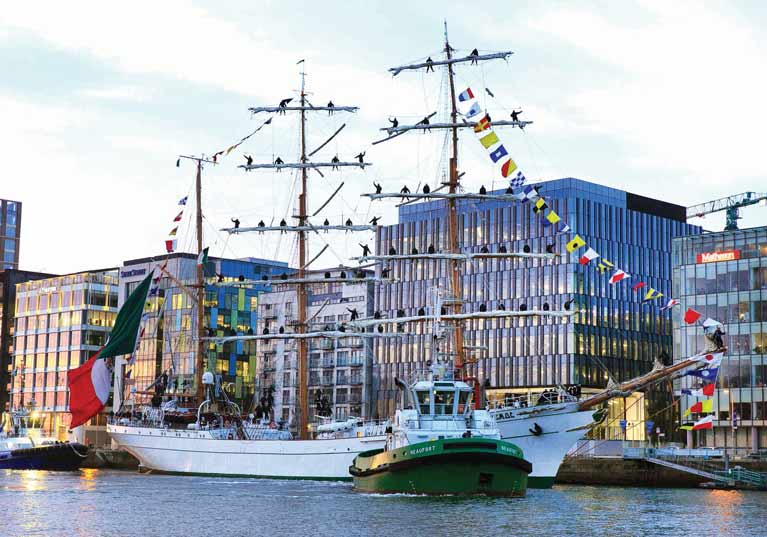 Majestic Tall Ships on the Liffey
Majestic Tall Ships on the Liffey
History in the Making
Historical maps, engineering drawings and photographs continue to emerge and be displayed online as the Port Heritage team progresses with the digitisation of thousands of images from Dublin Port’s 300-year-old archive. The material gives a fascinating insight into life at the port down through the ages and has proven invaluable to a host of local history events, talks, tours and evenings this year, including an exhibition celebrating the Bicentenary of Bullock Harbour, organised by the Dublin Port Archive in association with Bullock Harbour Preservation Association and dlr LexIcon.
New Pilot Boat Arrives into Dublin Port
Dublin Port Company’s new Pilot Boat named DPC Tolka has arrived into Dublin Port at the weekend.
The state-of-the-art vessel will allow marine pilots to reach and board larger ships in all weather conditions from a greater distance out into Dublin Bay.
As Afloat reported last September, the leading UK boat builder Goodchild Marine Services Limited secured the contract to construct the new Boat.
The new 17.1 metre ORC vessel (originally expected to be delivered in July) is the first Pilot Boat for export by Norfolk-based Goodchild Marine Services Limited.
The boat is renowned for its fuel efficiency, capacity to cut emissions and ability to handle high speeds in bad weather owing to an innovative beak bow design which can steady the hull of the boat as it pitches into the sea.
Piloting the new vessel on her maiden voyage to Dublin was Alan Goodchild of the leading UK boat builder Goodchild Marine Services Limited, the Norfolk-based company that built DPC Tolka having secured the contract to construct the boat in 2018.
Taking delivery in Dublin Port was Harbour Master Captain Michael McKenna and Assistant Harbour Master Tristan Murphy. The new addition to the port’s fleet of working vessels, which includes tug boats Shackleton and Beaufort, multi-purpose workboat the Rosbeg, and pilot boats Liffey and Camac will replace the oldest pilot boat Dodder, which now retires from service after 23 years.
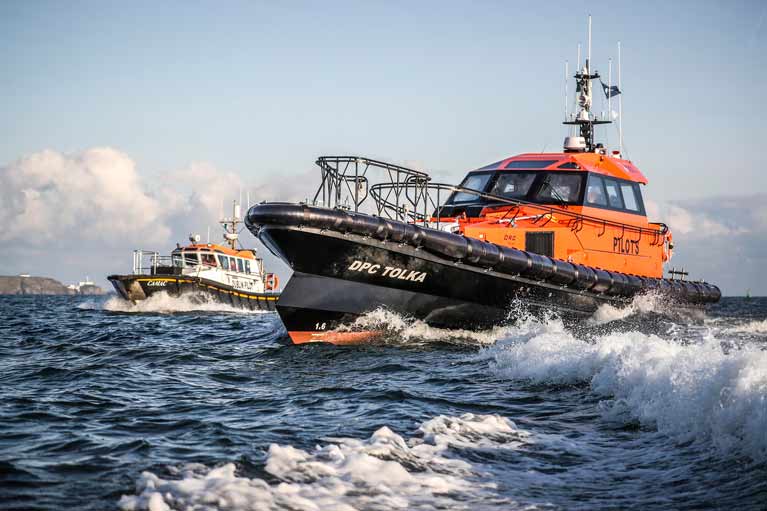
Designed by French Naval Architect Pantocarene for both fuel efficiency and performance in challenging weather conditions, DPC Tolka features the latest navigational and safety equipment on board, including a dedicated Pilot workstation in the wheelhouse and hydraulic Man Overboard Recovery Platform at the stern.
With shipping companies increasingly deploying longer, deeper ships capable of carrying more cargo, DPC Tolka represents a vital upgrade in the provision of pilotage services at the Port and will allow Dublin Port’s team of highly skilled marine pilots to reach and board these ships in all weather conditions from a greater distance out into Dublin Bay.
Dublin Port Harbour Master, Captain Michael McKenna, said: “Dublin Port Company is delighted to take delivery of DPC Tolka, and we’ve already started training our pilots and pilot boat teams on the workings of the new vessel ahead of entering service in the coming weeks. Demand for pilotage continues to grow as more and more ships service Dublin Port, and DPC Tolka will help meet the operational and navigational needs of both regular customers and visiting vessels in the years ahead. Our thanks to the crew at Goodchild Marine for their skills and workmanship in designing and delivering this vessel.”
Eamonn O’Reilly, Chief Executive, Dublin Port Company, said: “Investment in infrastructure is not simply confined to marine engineering works such as building quay walls, but also extends to the fleet that keeps the Port operational around the clock. Our pilots increasingly need to embark and disembark from much larger capacity ships, often in poor weather conditions or at peak times when demands for pilotage services are highest. DPC Tolka has allowed us to upgrade our equipment in line with customer investment in new ships and additional capacity on existing routes.”
Alan Goodchild, Managing Director, Goodchild Marine, said: “Our flagship ORC range of pilot boats are certainly making waves within the industry and we are delighted to be able to export our first ORC 171 to the Dublin Port Company.
“The pilot operation across the UK and Europe now demands bigger and stronger boats that can withstand the most challenging conditions. We believe we have responded to market demand by producing such a vessel.”
Steve Pierce, General Manager, Goodchild Marine said: “It is very important for us to consider the impact that our boats make, both financially and environmentally. Our ORCs are becoming renowned for cutting fuel emissions, with customers reporting fuel savings of up to 40% a year, which we hope is an incentive for both existing and potential clients.”


























